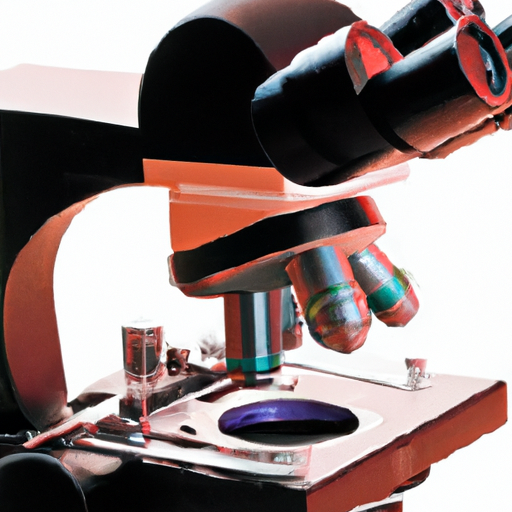Are you a student looking for the perfect digital microscope? Look no further! In this article, we will guide you through the process of finding the best digital microscope for your needs. From high-resolution imaging to user-friendly features, we will explore all the essential factors to consider when choosing a digital microscope that will enhance your learning experience. So, get ready to embark on a journey of discovery as we help you find the perfect digital microscope for students like you.

1. Understanding Digital Microscopes
Digital microscopes are powerful tools that allow you to explore the microscopic world with ease. They utilize advanced imaging technology to provide clear and detailed images of tiny objects. These microscopes come in various forms and have numerous advantages over traditional microscopes. They play a crucial role in enhancing students’ learning experiences by allowing them to observe and study microscopic specimens more effectively.
1.1 How do digital microscopes work?
Digital microscopes use a combination of optics, imaging sensors, and software to capture and display images. Instead of looking through an eyepiece like with traditional microscopes, digital microscopes display the magnified image on a screen, be it a built-in LCD display or a connected device such as a computer or smartphone. The microscope’s lens system magnifies the specimen, while the imaging sensor captures the light reflected or transmitted through the sample. The captured image is then processed and displayed in real-time.
1.2 Advantages of digital microscopes over traditional microscopes
Digital microscopes offer several advantages over traditional microscopes. Firstly, they provide the convenience of viewing specimens on a screen, allowing multiple people to observe simultaneously. This is particularly beneficial in educational settings where students can easily follow along with the teacher’s instructions. Additionally, digital microscopes often have built-in features such as image and video capture, which can be further analyzed or used for educational purposes. Another advantage is the ease of sharing and storing images digitally, eliminating the need for physical slides and storage space.
1.3 Importance of digital microscopes for students
Digital microscopes are of great importance for students in various fields of study. They provide a hands-on learning experience that helps students grasp complex concepts and better understand the microscopic world. In biology and life sciences, students can observe cells, tissues, and microorganisms in detail, aiding their understanding of biological processes. In chemistry and material sciences, they can examine the structure and composition of various substances, facilitating research and experimentation. Similarly, in geology and earth sciences, digital microscopes enable students to study rocks, minerals, and fossils with exceptional clarity. These microscopes also serve a crucial role in forensic science, engineering, and art restoration, allowing students to develop practical skills and enhance their creativity.
2. Factors to Consider
When choosing a digital microscope for students, there are several important factors to consider. Each factor plays a role in determining the overall usability and functionality of the microscope.
2.1 Magnification power
Magnification power is a crucial factor to consider when selecting a digital microscope. It determines how much the specimen can be enlarged and observed. Higher magnification allows for more detailed examination of tiny structures, but it is also important to consider the working distance or the distance between the lens and the specimen.
2.2 Resolution
Resolution refers to the level of detail and sharpness in the captured images. Higher resolution ensures clearer and more accurate representations of the specimens. Look for digital microscopes with high-resolution imaging sensors to ensure the best image quality.
2.3 Connectivity options
Consider the connectivity options offered by the digital microscope. Some microscopes offer USB connectivity, allowing you to connect the microscope to a computer or laptop. Others may offer Wi-Fi connectivity, enabling wireless connections to various devices. Evaluate the connectivity options that align with your needs and preferences.
2.4 Ease of use
For students, it is important to choose a digital microscope that is user-friendly and easy to operate. Consider the layout and accessibility of the controls, as well as the intuitiveness of the interface. A microscope with user-friendly features will enhance students’ ability to navigate and utilize the microscope effectively.
2.5 Portability
Portability is especially important for students who may need to transport the microscope between classrooms or field trips. Look for lightweight and compact designs that are easy to carry. Many digital microscopes offer battery-powered options, further enhancing portability.
2.6 Price range
Consider your budget when selecting a digital microscope. There is a range of options available at different price points. While more expensive microscopes may offer advanced features, there are also affordable options that provide satisfactory performance for educational purposes.
2.7 Durability
As students can be rough with equipment, durability is a crucial factor to consider. Look for digital microscopes that are built with sturdy materials and have protective features to withstand the rigors of student use.
2.8 Manufacturer’s reputation
Research and consider the manufacturer’s reputation when selecting a digital microscope. Look for well-established brands known for their quality and reliability. Reading customer reviews and seeking recommendations can help gauge a manufacturer’s reputation.
2.9 Warranty and customer support
Check the warranty and customer support offered by the manufacturer. A warranty ensures that you are covered in case of any defects or malfunctions. Reliable customer support is essential for prompt assistance and resolving any issues that may arise with the microscope.
2.10 Compatibility with various devices
Consider the compatibility of the digital microscope with various devices. Ensure that the microscope is compatible with your computer, laptop, or smartphone to ensure seamless connectivity and ease of use.

3. Types of Digital Microscopes
Digital microscopes come in various forms, each catering to specific needs and preferences. Consider the different types to determine which one best suits your requirements.
3.1 Handheld digital microscopes
Handheld digital microscopes are compact and portable. They are often battery-powered and allow for easy observation of objects without the need for extensive setup. These microscopes are particularly useful for examining larger objects or surfaces, and they provide the flexibility to observe specimens in various locations.
3.2 USB digital microscopes
USB digital microscopes connect directly to a computer or laptop via a USB port. They offer easy integration with existing technology and provide a convenient way to capture and analyze images. USB microscopes are commonly used in educational settings where they can be shared among multiple users.
3.3 Wi-Fi digital microscopes
Wi-Fi digital microscopes enable wireless connectivity, allowing you to connect the microscope to a smartphone, tablet, or computer without the need for physical connections. This type of microscope offers the flexibility to observe and capture images from a distance, making it convenient for group learning or remote observations.
3.4 Standalone digital microscopes
Standalone digital microscopes, also known as desktop microscopes, are designed to be used in a stationary setup. They often have a larger base and offer a more stable platform for observing specimens. These microscopes are commonly found in laboratories and research facilities where a dedicated workspace is available.
3.5 Smartphone-compatible digital microscopes
Smartphone-compatible digital microscopes are specifically designed to be used with smartphones. They typically attach directly to the smartphone camera lens. This type of microscope leverages the high-quality cameras found in smartphones and allows for easy capture and sharing of images.
4. Popular Digital Microscope Brands
There are several reputable digital microscope brands that offer high-quality products suitable for student use. Consider these popular brands when selecting a digital microscope:
4.1 Celestron
Celestron is a well-known brand in the field of astronomy, but they also offer a range of digital microscopes. Their microscopes are known for their durability and excellent image quality, making them a popular choice among students.
4.2 Carson
Carson is another reputable brand that specializes in optical devices, including digital microscopes. They offer a variety of models suitable for different applications, often focusing on portability and ease of use.
4.3 AmScope
AmScope is a trusted brand that provides a wide range of microscopes tailored to different needs. They offer affordable options without compromising on quality, making them an excellent choice for students.
4.4 Swift
Swift is a brand that combines reliable performance with affordability. They offer digital microscopes with various features and options, catering to different educational requirements.
4.5 Dino-Lite
Dino-Lite is well-regarded in the field of digital microscopy. Their microscopes are known for their high resolution and superior image quality, making them suitable for advanced scientific study.
4.6 Levenhuk
Levenhuk offers digital microscopes that combine modern design with functionality. They offer a range of models suitable for students, with features such as easy connectivity and user-friendly interfaces.
4.7 Aven
Aven is a brand recognized for its high-quality optical tools and devices. They offer digital microscopes with exceptional imaging capabilities, ensuring students can observe specimens with remarkable detail.
4.8 National Geographic
National Geographic, renowned for its exploration and scientific research, also offers digital microscopes. Their microscopes are designed to cater to the curiosity of young learners and provide educational value.
4.9 OMAX
OMAX is a brand that specializes in microscopes and related accessories. They offer digital microscopes suitable for both educational and professional applications, known for their precision and durability.
4.10 Plugable
Plugable is a brand that focuses on connectivity solutions, including digital microscopes. Their microscopes often feature easy connectivity options and are known for their compatibility with a wide range of devices.

5. Reviews and Ratings
When researching digital microscopes, it is important to consider reviews and ratings from various sources. Here are some avenues for gathering valuable insights:
5.1 Online customer reviews
Online retail platforms like Amazon often have customer reviews and ratings for specific digital microscope models. These reviews can provide valuable information about the microscope’s performance, ease of use, and durability from the perspective of actual users.
5.2 Expert ratings and recommendations
Technology and education publications often review digital microscopes and provide expert ratings and recommendations. These reviews are conducted by knowledgeable individuals who assess the microscopes’ performance, features, and overall value.
5.3 Comparison websites
There are several websites dedicated to comparing and reviewing various products, including digital microscopes. These websites compile data and user reviews to help you evaluate and compare different models based on specifications, performance, and price.
5.4 Educational institution recommendations
Reach out to educational institutions, such as local schools or universities, to seek recommendations from educators or science departments. They may have insights based on their experience with specific models or brands.
5.5 Tips for evaluating reviews and ratings
When evaluating reviews and ratings, consider the credibility of the source. Look for reviews that provide detailed information and demonstrate a thorough understanding of the microscope’s features. Pay attention to both positive and negative reviews to get a comprehensive view of the product.
6. Top Digital Microscopes for Students
Based on the considerations discussed earlier and the reputation of various brands, here are some top digital microscopes suitable for students:
6.1 Celestron 44341 LCD Digital Microscope
The Celestron 44341 LCD Digital Microscope features a built-in LCD screen, making it a portable and user-friendly option. It offers a magnification range of up to 600x and has a high-resolution imaging sensor.
6.2 AmScope M150C-I 40X-1000X All-Metal Optical Glass Lenses Cordless LED Student Biological Compound Microscope
The AmScope M150C-I is a versatile biological compound microscope with a wide magnification range of 40x to 1000x. It features all-metal optical glass lenses for superior image quality and durability.
6.3 Carson eFlex 75x or 300x Power LED Lighted USB Digital Microscope
The Carson eFlex USB Digital Microscope is a compact and portable option that connects directly to a computer via USB. It offers adjustable magnification options of either 75x or 300x and has built-in LED illumination.
6.4 Dino-Lite AM2111 USB Handheld Digital Microscope
The Dino-Lite AM2111 is a handheld digital microscope with a magnification range of 10x to 50x. It connects to a computer via USB and provides high-resolution imaging for detailed observations.
6.5 Swift SW380T 40X-2500X Trinocular Compound Microscope
The Swift SW380T is a trinocular compound microscope that offers adjustable magnification from 40x to 2500x. It provides excellent image quality, a sturdy build, and is equipped with a trinocular port for easy image capture.
6.6 Levenhuk DTX 90 Portable Digital Microscope
The Levenhuk DTX 90 is a portable digital microscope with a built-in camera. It offers magnification up to 300x and features a user-friendly interface for easy operation.
6.7 Aven Inc. 26700-209 Digital Handheld Microscope
The Aven Inc. 26700-209 is a handheld digital microscope with a 10x to 200x magnification range. It connects to a computer via USB, allowing for easy image capture and analysis.
6.8 Plugable USB 2.0 Digital Microscope
The Plugable USB 2.0 Digital Microscope offers adjustable magnification from 20x to 250x. It features built-in LED lighting and connects directly to a computer via USB.
6.9 National Geographic 3-in-1 USB Microscope
The National Geographic 3-in-1 USB Microscope combines the functionality of a handheld, stand-alone, and flexible microscope. It offers up to 200x magnification and connects to various devices via USB.

7. Pricing and Where to Buy
Digital microscopes for students can range in price depending on the brand, features, and magnification capabilities. Here are some options for purchasing:
7.1 Average price range for student digital microscopes
The average price range for digital microscopes suitable for students is between $50 and $300. Higher-end models with advanced features may exceed this range.
7.2 Online retailers (Amazon, eBay, etc.)
Online retailers such as Amazon and eBay offer a wide selection of digital microscopes from various brands. They often have competitive prices and customer reviews to help inform your decision.
7.3 Official manufacturer websites
Official manufacturer websites are another good source for purchasing digital microscopes. They often provide product specifications, user manuals, and warranty information.
7.4 Local educational supply stores
Local educational supply stores often carry digital microscopes, especially those catering to science education. Visit these stores to get hands-on support and advice from knowledgeable staff.
7.5 Second-hand markets
Consider checking second-hand markets such as classified ads or online marketplaces for used digital microscopes. However, be sure to thoroughly evaluate their condition and functionality before purchasing.
8. Tips for Using a Digital Microscope
To maximize your experience with a digital microscope, consider these tips for effective usage:
8.1 Proper setup and calibration
Follow the manufacturer’s instructions for setup and calibration of the digital microscope. This ensures optimal image quality and accurate measurements.
8.2 Adjusting magnification and focus
Experiment with different magnification levels and focus adjustments to obtain the desired level of detail. Practice using the microscope to get comfortable with these adjustments.
8.3 Using appropriate lighting techniques
Utilize the appropriate lighting techniques for your specific application. Adjust the intensity and angle of the light source to minimize glare and enhance visibility.
8.4 Capturing and saving images or videos
Take advantage of the microscope’s image and video capture capabilities. Learn how to capture and save images or videos for later analysis or documentation.
8.5 Cleaning and maintaining the microscope
Regularly clean the lens, stage, and other components of the microscope using appropriate cleaning tools and solutions. Follow the manufacturer’s guidelines for maintenance to ensure longevity and optimal performance.

9. Educational Applications
Digital microscopes have numerous educational applications across various disciplines. Here are some examples:
9.1 Biology and life sciences
In biology and life sciences, digital microscopes enable students to observe and study cells, tissues, microorganisms, and biological processes in greater detail. They aid in the understanding of anatomy, physiology, genetics, and more.
9.2 Chemistry and material sciences
In chemistry and material sciences, digital microscopes allow students to examine the structure, composition, and characteristics of various substances. They can observe crystal formations, analyze chemical reactions, and study the properties of different materials.
9.3 Geology and earth sciences
Digital microscopes are valuable tools for geology and earth sciences, allowing students to closely examine rocks, minerals, fossils, and geological formations. They aid in identifying and studying different geological specimens.
9.4 Forensics and crime scene investigations
Digital microscopes play a role in forensic science and crime scene investigations. They help students analyze trace evidence, fingerprints, hair, fibers, and other microscopic materials relevant to criminal investigations.
9.5 Engineering and technology
In engineering and technology, digital microscopes are used for detailed analysis of components, circuit boards, and structures. They assist in the examination of small mechanical parts and facilitate precision measurements.
9.6 Art and restoration
Digital microscopes can be useful in art restoration and conservation. They enable students to study paintings, sculptures, and other artworks at a microscopic level, aiding in the identification of materials, techniques, and potential restoration needs.
10. Conclusion
Digital microscopes are invaluable tools for students to explore and study the microscopic world. By understanding how digital microscopes work and considering the factors discussed, students can choose the best microscope for their needs. The market offers various types and models, and reputable brands provide quality options. Reviews, ratings, and recommendations serve as helpful guides in making informed decisions. Digital microscopes have a wide range of educational applications, and their use enhances students’ understanding and engagement in various subjects. With the right digital microscope, students can unlock a new level of scientific learning and discovery.




